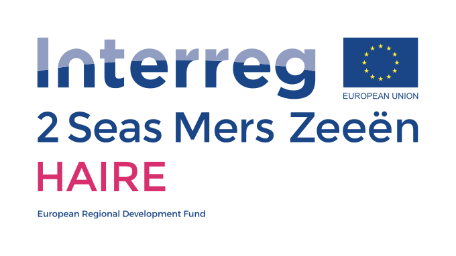Our French intern, Valentine, has again translated this month’s blog for us into French. It is a research reflection by Shuks Esmene, our postdoctoral research fellow. To read the original English language version, click here.
A l’occasion des ateliers CREATE, les partenaires du projet HAIRE se sont rassemblés pour discuter de leurs premières idées d’innovations destinées à améliorer le bien-être des séniors dans les sites pilotes. Les outils de recherche utilisés dans le cadre du projet représentent un aspect essentiel de l’apprentissage HAIRE. En particulier, les expériences et les idées de tous les partenaires, y compris des bénévoles et des participants, sont aussi importantes que ces outils le sont pour identifier des actions axées sur la personne et adaptées au milieu qui soient pertinentes à échelle locale.
Notre atelier de poésie a montré que les partenaires de prestation et les équipes de recherche du projet HAIRE sont parvenus à élaborer un environnement favorable à la discussion – même en ces temps troublés ! Les souvenirs de ces personnes âgées avec qui nous avons des liens privilégiés, par exemple des parents, des grands-parents, d’autres membres de la famille et des amis, ont inspiré une séance riche en émotions. Un de nos partenaires a fait remarquer :
« Ce ne sont pas des larmes de tristesse ! »
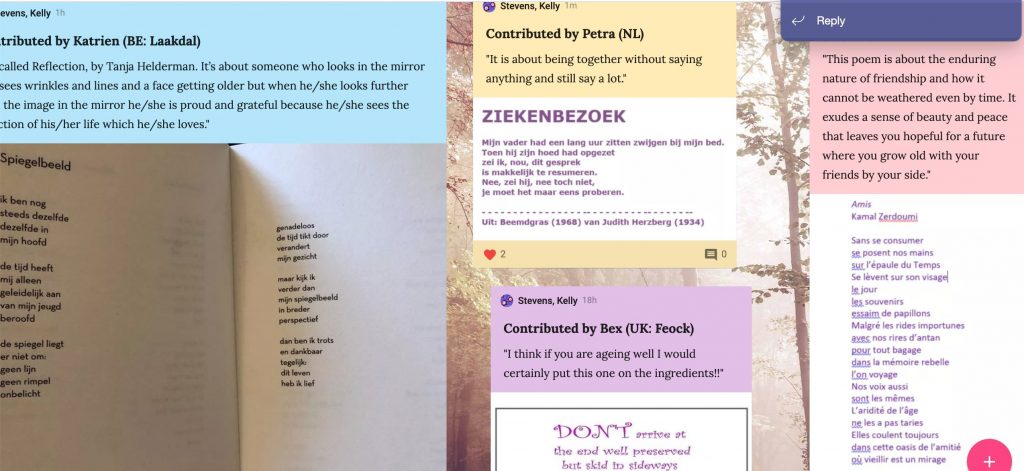
La remarque ci-dessus concernait un grand-parent défunt et résume la façon dont nos liens avec les personnes qui comptent pour nous s’étendent au-delà de leur présence physique auprès de nous. Bien qu’elles ne fussent qu’une parenthèse parmi les autres activités du projet, les réflexions que nous tirons de telles expériences peuvent aider HAIRE à amorcer des conversations relatives à l’intégration des soins dans nos communautés. Des soins plus approfondis. Des soins qui surpassent les besoins fonctionnels des individus. Ces besoins sont extrêmement importants, bien sûr. Cependant, le bien-être ne se limite pas à la somme des besoins fonctionnels d’un individu.
Les Conversations Guidées du projet HAIRE ont révélé que les activités et les passions qui importent aux participants (marcher, tricoter, lire et se rendre à des marchés locaux, entre autres) leur ont apporté de la joie et, malheureusement, de la tristesse lorsqu’ils n’ont pu s’y adonner pendant la pandémie. Ces conclusions ne sont en aucune façon propres au projet HAIRE, mais elles lui offrent plusieurs possibilités. Le réseau HAIRE, constitué de personnes soudées et attentionnées, va nous permettre de réfléchir différemment à notre façon de procéder face à ces conclusions. Certes, il est important de faire une liste des activités et des passions présentes dans une région, et de s’assurer que ces activités sont proposées à ses habitants, mais il faudrait aussi offrir l’opportunité aux séniors de développer de nouveaux centres d’intérêts et de nouvelles passions – ce serait une façon d’ajouter de la capacité à un lieu donné. La variété des activités et les activités extracurriculaires sont considérées comme une partie fondamentale du développement de l’enfant (1).
Je pense souvent à cette façon que nous avons d’essayer de trouver et de doser un assortiment d’activités spécifiques dont la population adulte puisse bénéficier – plutôt que de nous appliquer à mieux comprendre les modalités du bien-être de chaque individu. Comme nous l’avons dit durant nos discussions sur l’innovation au deuxième jour des ateliers CREATE, cela peut faire la différence d’« être prêt à commencer modestement » afin de produire des innovations qui restent ouvertes aux contributions des habitants – particulièrement si les opinions et points de vue reçoivent une réponse et ne sont pas perdus au fil des démarches administratives. A ce titre, les solutions numériques contribuent largement à améliorer la sensibilisation, mais c’était aussi encourageant de voir des idées se développer lors des ateliers autour des activités en face à face et de la notion d’« aller vers les gens ».

Dans leurs réponses aux Conversations Guidées, les participants ont communiqué l’importance qu’ils attachent aux interactions en face à face et aux évènements de rassemblement convivial. De plus, même si nous l’avons appris par le biais d’anecdotes, nous ne pouvons oublier que les commerçants et les docteurs étaient bien plus profondément intégrés dans les quartiers ruraux par le passé. Les services avaient plus souvent lieu en face à face, et ces expériences doivent être prises en compte lorsque l’on réunit des personnes âgées.
Par ailleurs, des préoccupations primordiales vis-à-vis du profil des participants recrutés jusqu’ici ont été soulevées lors des ateliers CREATE. On considère souvent qu’une méthode de communication qui attire et inclus les groupes vulnérables et marginalisés représente un défi (2). Les communautés inclusives doivent s’assurer que tout le monde sent qu’il ou elle fait partie du lieu dans lequel il ou elle vit, et que l’opportunité d’exprimer ses opinions leur soit donnée de façon à ce que tout le monde puisse contribuer à façonner l’avenir du lieu en question. Parvenir à une compréhension plus inclusive du bien-être représentera un défi important pour le projet HAIRE, et la démarche consistant à « être prêt à commencer modestement » pourra nous être bénéfique dans cette mesure également. La recherche a parfois tendance à se focaliser sur des chiffres et des objectifs à accomplir, tous les deux générés par des groupes larges et soi-disant représentatifs. Toutefois, si nous nous posons des questions essentielles sur les points de vue variés que nous avons recueillis pendant les Conversations Guidées, nous pouvons commencer modestement. Des questions telles que : comment se fait-il que quelqu’un qui s’est occupé des autres, et qui a travaillé dur dans un secteur qui n’est pas généreux économiquement, peut se retrouver dans une position financière précaire plus tard dans sa vie ?, et, que pouvons-nous faire pour impliquer quelqu’un à échelle locale quand cette personne n’a pas pu développer et/ou approfondir des centres d’intérêt à cause d’une enfance ou d’un début de vie d’adulte mouvementés ?
Enfin, la question qui selon moi ressort le plus de nos séances CREATE est :
« Pourquoi sommes-nous, en tant que société, si mauvais à cela ? »
La réponse se trouve peut-être dans une nouvelle conception des soins, une conception selon laquelle les soins seraient reçus et donnés par des individus dans leurs communautés, et ne seraient pas simplement un service dédié à répondre aux besoins fonctionnels des personnes âgées. Fait encourageant, nous avons parfois accompli cela au sein de projet HAIRE – que ce soit entre les chercheurs et les équipes de prestation, entre les équipes de prestation et les bénévoles, et/ou entre les bénévoles et les participants. Notre prochain défi sera de trouver des façons d’impliquer les donneurs de soins dans le projet, sur tous les sites pilotes, plus étroitement encore. J’ai hâte d’affronter ce défi.
Footnotes 1. Metsäpelto, R., & Pulkkinen, L. (2012). Socioemotional Behavior and School Achievement in Relation to Extracurricular Activity Participation in Middle Childhood. Scandinavian Journal Of Educational Research, 56(2), 167-182. doi: 10.1080/00313831.2011.581681 2. Meyer, C., Evans, D., Soucat, A., Dkhimi, F., Akweongo, P., & Kessy, F. et al. (2018). Leaving no one behind? Reaching the informal sector, poor people and marginalised groups with Social Health Protection. Journal Of Poverty And Social Justice. doi: 10.1332/175982718x1536143686739
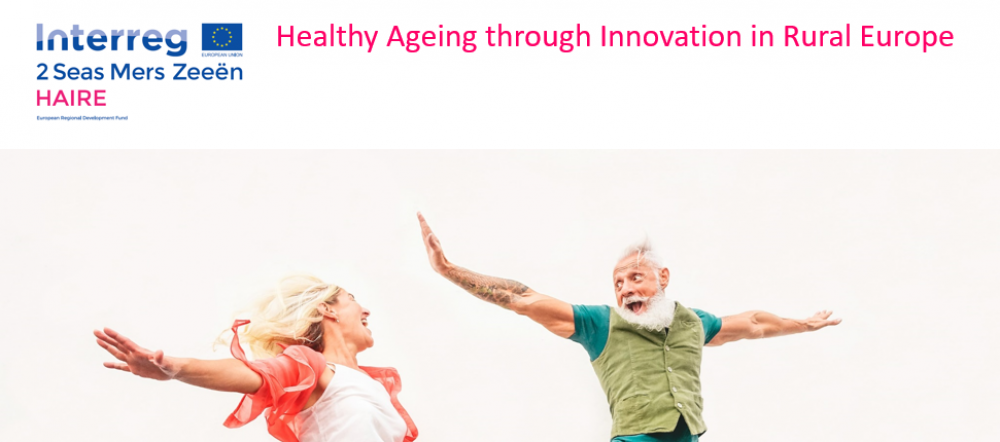



 Elle vise à assurer une prise en charge de qualité des publics vulnérables. L’objectif de la formation est de former les professionnels de demain capables de répondre aux nouveaux besoins et aux nouvelles attentes des seniors. L’enjeu de la recherche est de permettre des innovations au service de la qualité de vie des seniors. Cependant, avant d’entreprendre toutes actions visant à favoriser leur maintien à domicile tout en luttant contre leur isolement en milieu rural, il était nécessaire de comprendre l’environnement dans lequel ces personnes évoluaient. Ce fut le challenge pour l’année 2021 pour les 22 étudiants issus du Master 1 « Management sectoriel ».
Elle vise à assurer une prise en charge de qualité des publics vulnérables. L’objectif de la formation est de former les professionnels de demain capables de répondre aux nouveaux besoins et aux nouvelles attentes des seniors. L’enjeu de la recherche est de permettre des innovations au service de la qualité de vie des seniors. Cependant, avant d’entreprendre toutes actions visant à favoriser leur maintien à domicile tout en luttant contre leur isolement en milieu rural, il était nécessaire de comprendre l’environnement dans lequel ces personnes évoluaient. Ce fut le challenge pour l’année 2021 pour les 22 étudiants issus du Master 1 « Management sectoriel ». 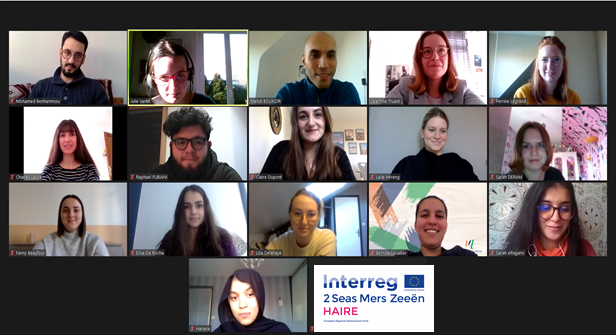 Ceux-ci ont travaillé en collaboration avec les partenaires des Flandres Intérieures afin de produire un diagnostic démographique, de l’accessibilité et des services du territoire par le biais de la boite à outils HAIRE. Tout l’enjeu de ce travail repose maintenant sur les actions à mettre en œuvre afin de lutter contre cet isolement rural en Flandre Intérieure.
Ceux-ci ont travaillé en collaboration avec les partenaires des Flandres Intérieures afin de produire un diagnostic démographique, de l’accessibilité et des services du territoire par le biais de la boite à outils HAIRE. Tout l’enjeu de ce travail repose maintenant sur les actions à mettre en œuvre afin de lutter contre cet isolement rural en Flandre Intérieure.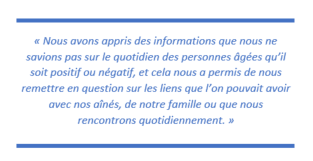
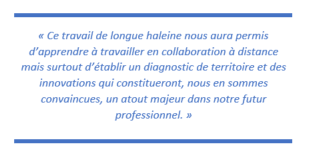 Ce pourquoi les étudiants du Master étudient actuellement une gamme d’innovation sociale, en rupture par rapport à l’existant ou se basant sur une solution existante pour significativement l’améliorer. Ces nouvelles solutions, intégrant les besoins repérés dans le discours des personnes âgées, seront proposées aux partenaires français lors des ateliers CREATE, voués à la conception d’innovations locales.
Ce pourquoi les étudiants du Master étudient actuellement une gamme d’innovation sociale, en rupture par rapport à l’existant ou se basant sur une solution existante pour significativement l’améliorer. Ces nouvelles solutions, intégrant les besoins repérés dans le discours des personnes âgées, seront proposées aux partenaires français lors des ateliers CREATE, voués à la conception d’innovations locales.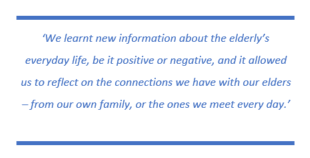 The Masters students are therefore studying a wide range of innovative social initiatives; some of them are a clean break from existing solutions, while others are based on existing solutions with the aim of improving them significantly. These new solutions,
The Masters students are therefore studying a wide range of innovative social initiatives; some of them are a clean break from existing solutions, while others are based on existing solutions with the aim of improving them significantly. These new solutions, 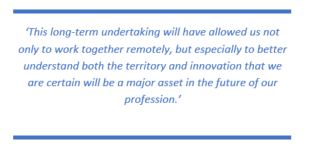 which take into account the needs that older people have expressed in conversation, will be brought forward to the French partners during the “CREATE workshops”, which are all about ideating local innovations.
which take into account the needs that older people have expressed in conversation, will be brought forward to the French partners during the “CREATE workshops”, which are all about ideating local innovations.
